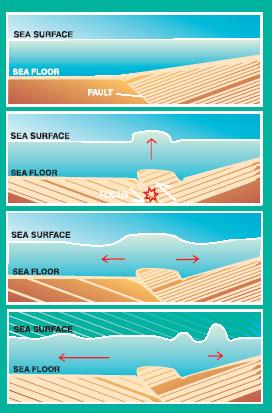A tsunami is a series of waves generated in an ocean or other body of water by a disturbance such as an earthquake, landslide, volcanic eruption, or meteorite impact. The picture at the left shows how an earthquake can generate a tsunami in the overlying water.
Undersea earthquakes, which typically occur at boundaries between Earth’s tectonic plates, cause the water above to be moved up or down. Tsunami waves are formed as the displaced water, which acts under the influence of gravity, attempts to find a stable position again.
Undersea landslides, which can be caused by large earthquakes, can also cause tsunami waves to form as water attempts to find a stable position.
Undersea volcano eruptions can create enough force to uplift the water column and generate a tsunami.
Asteroid impacts disturb the water from above, as momentum from falling debris is transferred to the water into which the debris falls.
On the picture you can see, that when movement along a fault moves the seafloor upward, water is also pushed upward and becomes tsunami waves. As the waves approach shallower water, they become higher.
Click on image for full size!
http://www.windows2universe.org/earth/tsunami2.html
Read more: http://www.windows2universe.org/earth/tsunami1.html
